IASR 42(10), 2021【THE TOPIC OF THIS MONTH】HIV/AIDS in Japan, 2020
PDF download(PDF:640.00KB)
The topic of This Month Vol.42 No.10(No. 500)
HIV/AIDS in Japan, 2020
(IASR Vol. 42 p213-215: October 2021)
HIV/AIDS surveillance in Japan began in September 1984. It was conducted under the AIDS Prevention Law between February 1989 and March 1999, and has operated under the Infectious Diseases Control Law since April 1999. Under the law, physicians must notify all diagnosed cases (see http://www.niid.go.jp/niid/images/iasr/34/403/de4031.pdf). The data presented in this article are from the annual report of the National AIDS Surveillance Committee for the year 2020 (published by the Tuberculosis and Infectious Diseases Control Division, the Ministry of Health, Labour and Welfare (MHLW), https://api-net.jfap.or.jp/status/japan/nenpo.html).
For surveillance purposes, newly diagnosed HIV-infected cases are classified into two categories, “HIV cases” and “AIDS cases” (see footnote*). The cumulative number of notified cases (excluding cases attributed to coagulating agents) between 1985 and 2020 was 22,489 for “HIV cases” (19,928 males, 2,561 females) and 9,991 for “AIDS cases” (9,121 males, 870 females) (Fig. 1). According to the National Survey of Blood Coagulation Abnormality Cases (as at 31 May 2020), the cumulative number of coagulating-agent-related HIV infection cases was 1,440, including 726 deaths. Globally, in 2020, an estimated 37.7 million persons were living with HIV, an estimated 1.5 million persons became newly infected with HIV, and an estimated 680,000 persons died from AIDS-related illness (UNAIDS Fact Sheet 2021; https://www.unaids.org/en/resources/fact-sheet).
*HIV surveillance in Japan counts a case as an “HIV case” if a case is laboratory diagnosed with HIV infection (but without manifestation of AIDS-indicator diseases), and as an “AIDS case” if a case is laboratory diagnosed with HIV infection and manifests AIDS-indicator diseases at the time of initial diagnosis and report. An HIV-infected case once registered as an “HIV case” is not registered as an “AIDS case” even if he /she subsequently develops AIDS. However, “AIDS cases” reported through 31 March 1999 include those who subsequently developed AIDS.
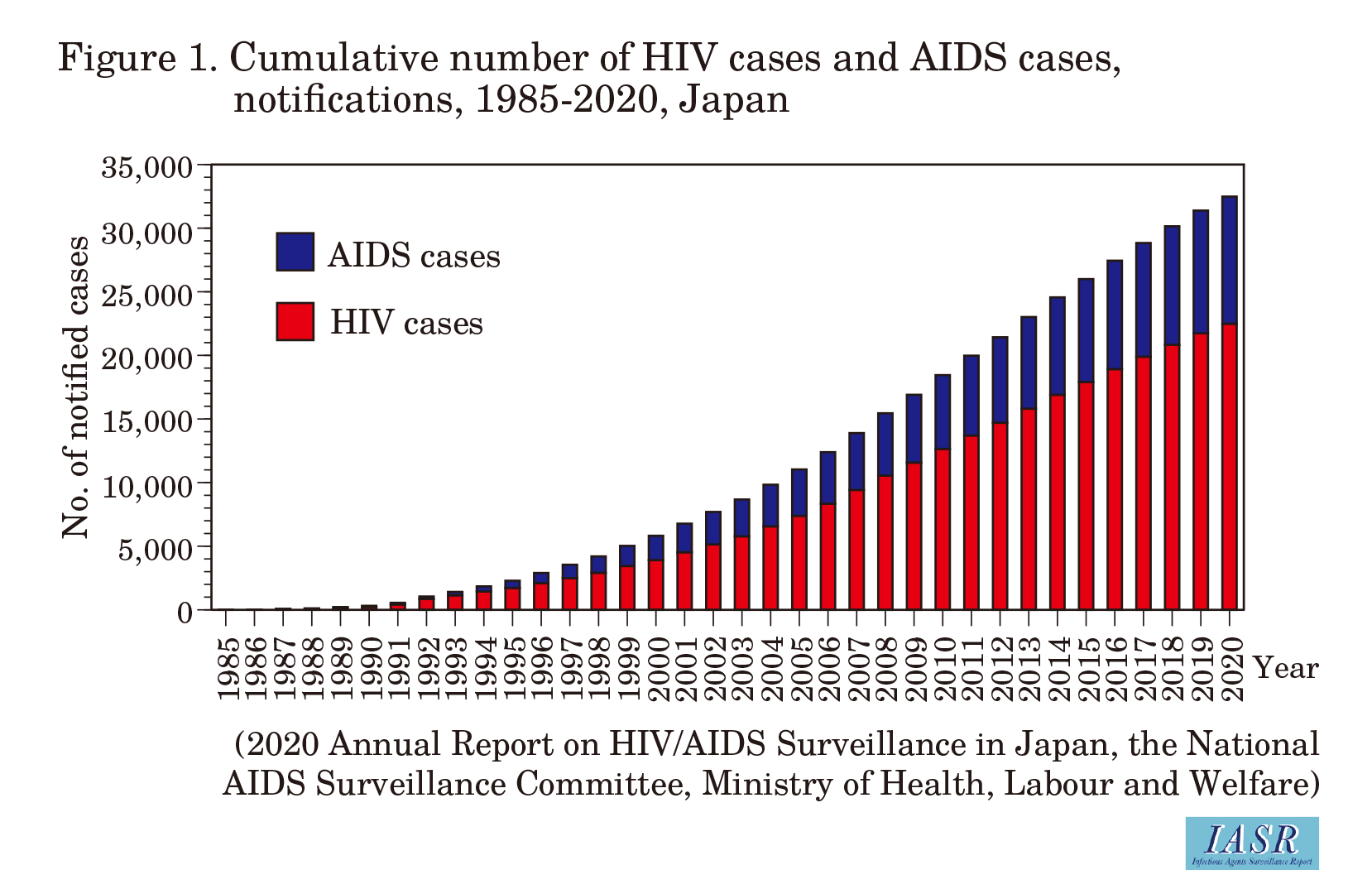
“HIV cases” and “AIDS cases” notified in Japan in 2020: In 2020, there were 750 new notifications of “HIV cases” (712 males, 38 females) and 345 new notifications of “AIDS cases” (328 males, 17 females) (Fig. 2). Although the annual number of “HIV cases” and “AIDS cases” newly notified had been on the decline in recent years, the number of newly notified “HIV cases” in 2020 showed the largest decrease since 1999, when surveillance began under the Infectious Diseases Control Law. In contrast, the number of newly notified “AIDS cases” in 2020 increased for the first time in four years since 2016. The proportion of new “AIDS cases” to the sum of new “HIV cases” and new “AIDS cases” decreased for three consecutive years through 2019, when it was 26.9%, but increased to 31.5% in 2020.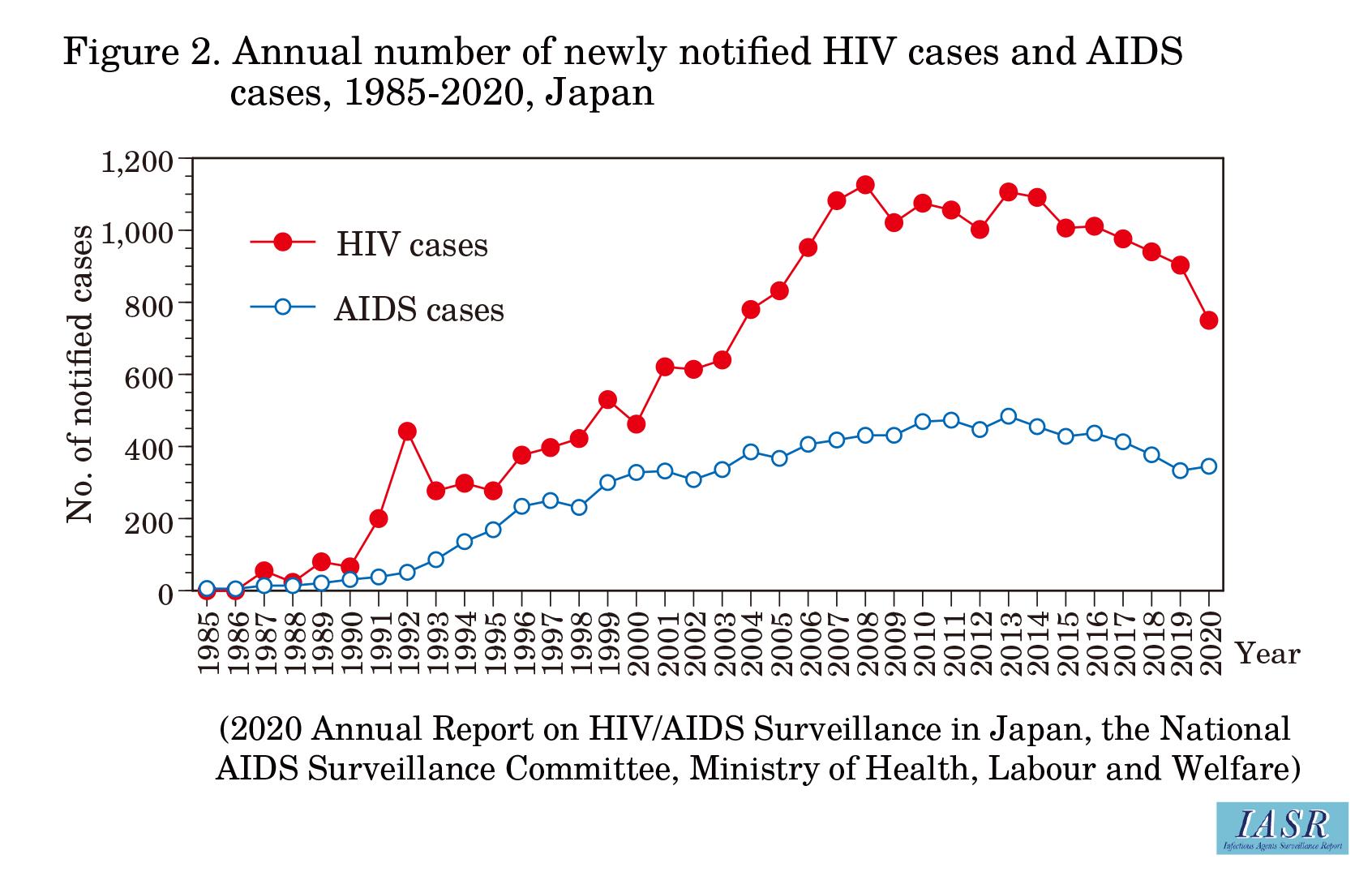
Of the 750 newly notified “HIV cases” in 2020, 619 were Japanese (598 males, 21 females) and 131 were non-Japanese (114 males, 17 females), with the number of Japanese males decreased from 741 in 2019 to 598 in 2020, the largest decline to date. On the other hand, the number of “HIV cases” in non-Japanese males decreased only slightly, from 116 in 2019 to 114 in 2020, and the proportion of non-Japanese males increased. Regarding the newly notified “AIDS cases”, the number of Japanese males increased slightly from 281 in 2019 to 282 in 2020, and the number of non-Japanese males increased from 37 to 46. The increasing trend in the proportion of non-Japanese males has been observed since before 2020.
Among the newly notified “HIV cases” in 2020, 72.4% (543/750) were attributed to male-to-male sexual contact (including bisexual contact), and among Japanese males, 78.1% (467/598) were attributed to male-to-male sexual contact (Fig. 3), with the majority in their 20s to 40s (Fig. 4). On the other hand, among the 750 “HIV cases”, 65 males (8.7%) were attributed to heterosexual contact, and among the 598 Japanese males, 53 (8.9%) were attributed to heterosexual contact. Among the 21 Japanese female “HIV cases”, 18 were attributed to heterosexual contact and 3 were attributed to other or unknown transmission routes. With regards to intravenous drug use among Japanese male “HIV cases”, 1-5 cases were notified annually since 2001, except in 2013, 2017, and 2018; while 4 such cases were notified in 2020.

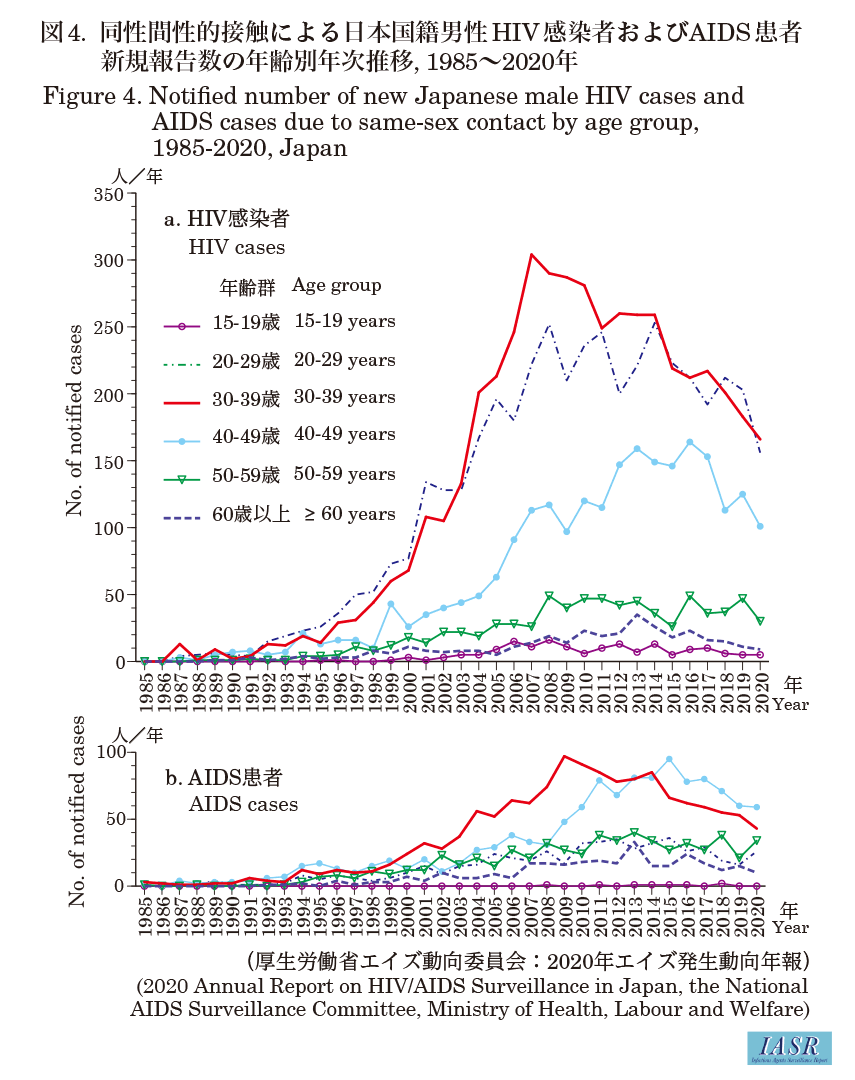
Geographic region suspected to be the place of infection: Until 1992, infections were acquired mainly abroad, but since then, most infections have been acquired in Japan. In 2020, 79.9% (599/750) of all newly notified “HIV cases” and 86.8% (537/619) of newly notified “HIV cases” among Japanese nationals were presumed to have acquired infection in Japan.
Place of notification (based on the geographic location of the notifying physician): The areas that notified a large number of “HIV cases” and “AIDS cases” in 2020 were the Kanto-Koshinetsu area (includes Tokyo Prefecture), which notified 412 “HIV cases” and 160 “AIDS cases”, followed by the Kinki area with 125 “HIV cases” and 54 “AIDS cases”, the Tokai area with 83 “HIV cases” and 45 “AIDS cases”, and the Kyushu area with 67 “HIV cases” and 41 “AIDS cases”. Comparing the prefectures by notifications per 100,000 population, 5 prefectures in Kyushu were in the top 10 for both “HIV cases” and “AIDS cases” (Table).
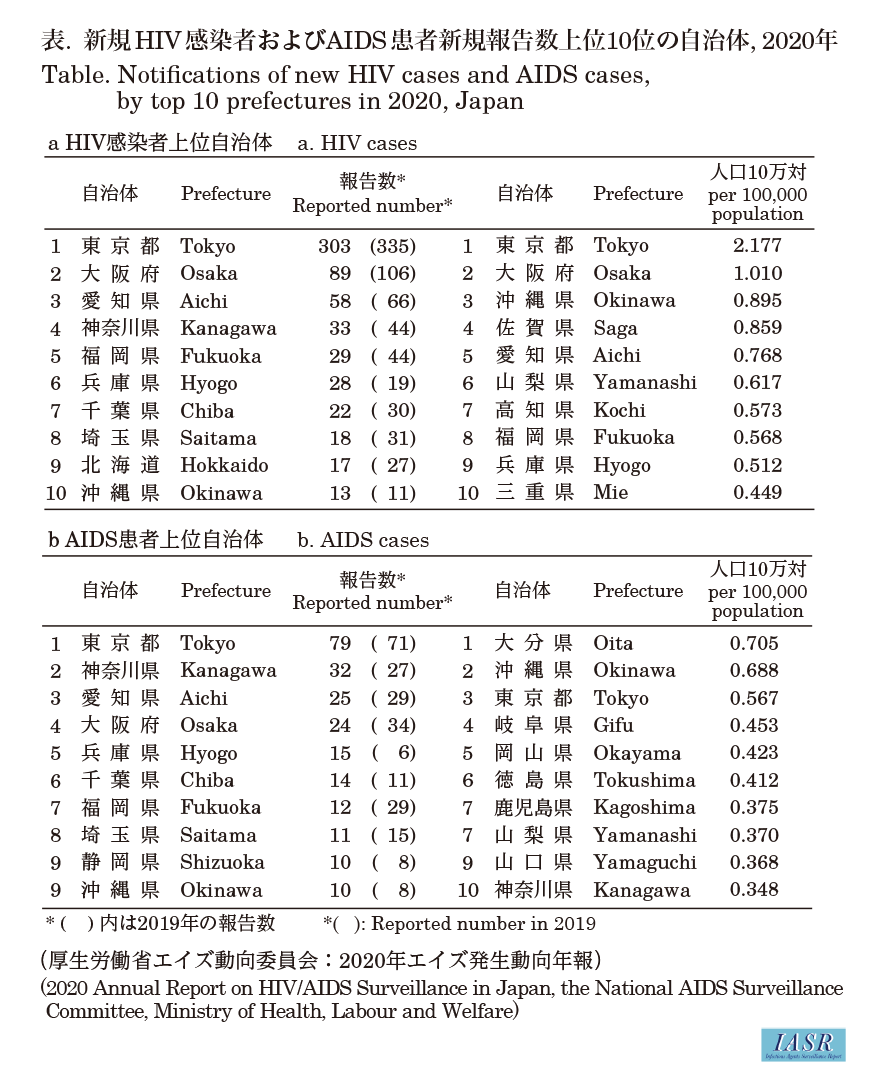
CD4 count at diagnosis: The CD4 count at the time of diagnosis was added to the reporting form of the National Epidemiological Surveillance of Infectious Diseases (NESID) system and its collection started from 2019. In 2020, 50.5% (379/750) of new “HIV cases” and 68.4% (236/345) of new “AIDS cases” were reported with CD4 count data. The proportion of new “HIV cases” with a CD4 count <200 /μL in 2020 was 28.2% (107/379), a decrease from the previous year [30.9% (142/459) in 2019] (Fig. 5).
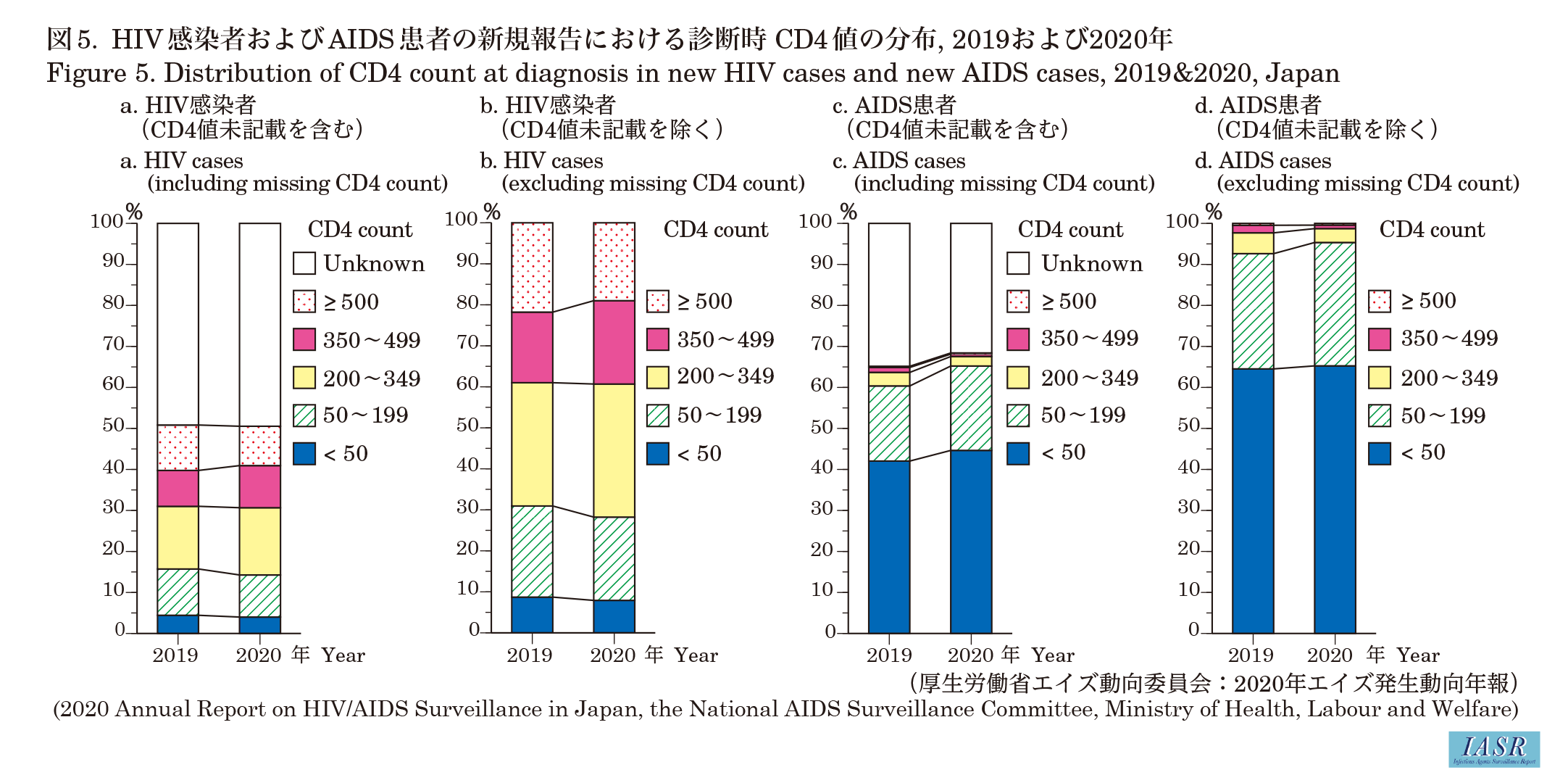
Reference information 1. HIV antibody positivity among blood donors: The number of HIV-positive cases and the number of HIV-positive cases per 100,000 blood donations have been decreasing in recent years, but in 2020, among 5,024,859 blood donations, 44 (41 males, 3 females) were HIV positive, which is 0.876 (male: 1.155; female: 0.203) per 100,000 blood donations, an increase from 0.782 (male: 1.057; female: 0.074) per 100,000 blood donations in 2019 (Fig. 6).
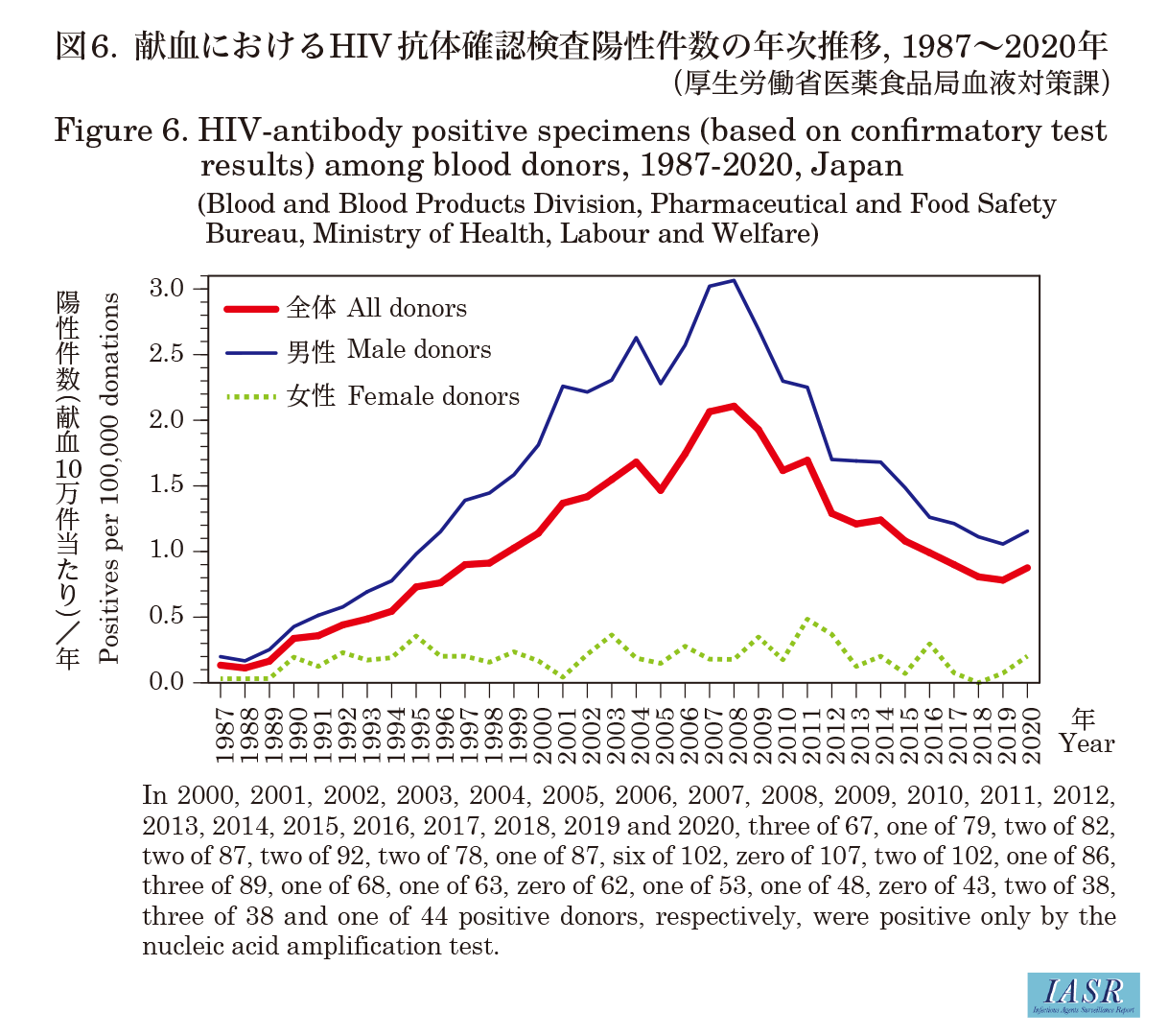
Reference information 2. HIV tests and consultations provided by local governments: The number of HIV tests conducted by local governments at public health centers and other aff iliate facilities was 68,998 in 2020, a substantial decrease from 2019 (142,260) (Fig. 7). The number of HIV-positive cases was 290 (437 in 2019) and the positivity rate was 0.42% (0.31% in 2019). The positivity rate was 0.32% (150/46,901) for the tests conducted at public health centers and 0.63% (140/22,097) for the tests done at other facilities, being higher at the latter. In addition, the number of persons who used consultation services in 2020 was 66,519, a considerable decrease from 2019 (129,695 consultations).
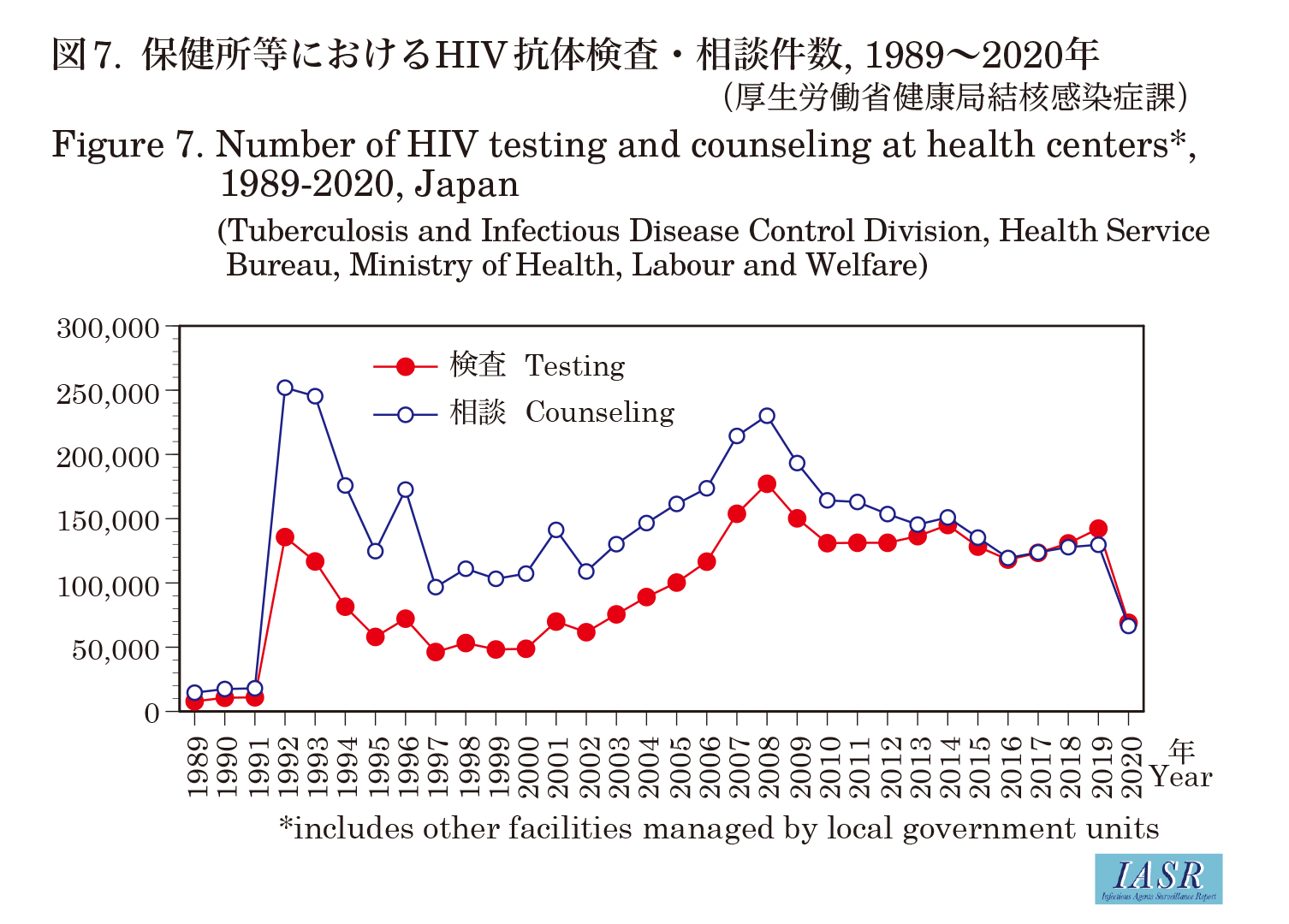
Conclusion: The annual number of both newly notified “HIV cases” and newly notified “AIDS cases” had been decreasing in recent years, and the number of new “HIV cases” in 2020 showed the largest decrease since the current surveillance system came into effect under the Infectious Diseases Control Law in 1999. In contrast, the number of new “AIDS cases” in 2020 increased for the first time in four years since 2016. The number of HIV tests and consultations at public health centers and other facilities conducted by local governments decreased considerably compared to the previous year. It should be noted that a substantial number of asymptomatic patients may not have been diagnosed due to the decrease in testing opportunities resulting from the pandemic of COVID-19, which was first reported in Japan in January 2020. The increase in the annual number of new “AIDS cases” for the first time in four years may partly reflect a delay in access to medical services among HIV-infected individuals with low CD4 counts.
Although HIV infection cannot be completely cured, it has become clear that by suppressing the viral load in blood with appropriate antiretroviral therapy, it is possible to maintain and restore immune function and prevent sexual transmission. While showing considerations for and respecting human rights, more than ever, it is necessary to raise awareness on the need for HIV testing for early diagnosis and early treatment. Based on the Guidelines for AIDS Prevention, it is also necessary to promote preventive measures, create a system that enables easy access to counseling and testing, provide testing opportunities at various settings, and facilitate an environment that enables easier access to medical care.

